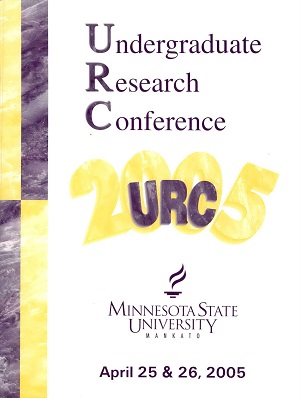The Effects of Mowing on Populations of Small Mammals at Swan Lake Wildlife Management Area, Minnesota
Location
CSU 255
Start Date
26-4-2005 10:00 AM
End Date
26-4-2005 12:00 PM
Student's Major
Biological Sciences
Student's College
Science, Engineering and Technology
Mentor's Name
Brock R. McMillan
Mentor's Department
Biological Sciences
Mentor's College
Science, Engineering and Technology
Description
Mowing or haying is a common land management practice in the Great Plains region. However, little is know about the effects of mowing on small mammal populations. Therefore, an experiment was designed to examine the effects of mowing on populations of small mammals at the Swan Lake Wildlife Management Area. A trapping grid comprised of 91 stations (13 stations x 7 stations) was established to sample contiguous mowed and unmowed habitat. Two large Sherman live traps were placed at each station. Traps were checked daily for five consecutive days. Species, sex, and weight were recorded for each animal that was captured. A G-test was used to statistically determine if populations were distributed randomly between the habitats at the study area. Six species of small mammals were captured. In decreasing order of abundance, the species were the northern shorttailed shrew (Blarina brevicauda; N =25), masked shrew (Sorex cinereus\N= 10), white-footed mouse (Peromyscus leucopus; N = 6), meadow vole (Microtus pennsylvanicus', N = 2) house mouse (Mus musculus; N =2), and ermine (Mustella erminea\N =\). There were no differences within or among populations between the two habitats examined. The results from this study are contrary to similar studies in other regions of the Great Plains. The inconsistencies are likely a result of the small scale and small sample sizes in the current study.
The Effects of Mowing on Populations of Small Mammals at Swan Lake Wildlife Management Area, Minnesota
CSU 255
Mowing or haying is a common land management practice in the Great Plains region. However, little is know about the effects of mowing on small mammal populations. Therefore, an experiment was designed to examine the effects of mowing on populations of small mammals at the Swan Lake Wildlife Management Area. A trapping grid comprised of 91 stations (13 stations x 7 stations) was established to sample contiguous mowed and unmowed habitat. Two large Sherman live traps were placed at each station. Traps were checked daily for five consecutive days. Species, sex, and weight were recorded for each animal that was captured. A G-test was used to statistically determine if populations were distributed randomly between the habitats at the study area. Six species of small mammals were captured. In decreasing order of abundance, the species were the northern shorttailed shrew (Blarina brevicauda; N =25), masked shrew (Sorex cinereus\N= 10), white-footed mouse (Peromyscus leucopus; N = 6), meadow vole (Microtus pennsylvanicus', N = 2) house mouse (Mus musculus; N =2), and ermine (Mustella erminea\N =\). There were no differences within or among populations between the two habitats examined. The results from this study are contrary to similar studies in other regions of the Great Plains. The inconsistencies are likely a result of the small scale and small sample sizes in the current study.



